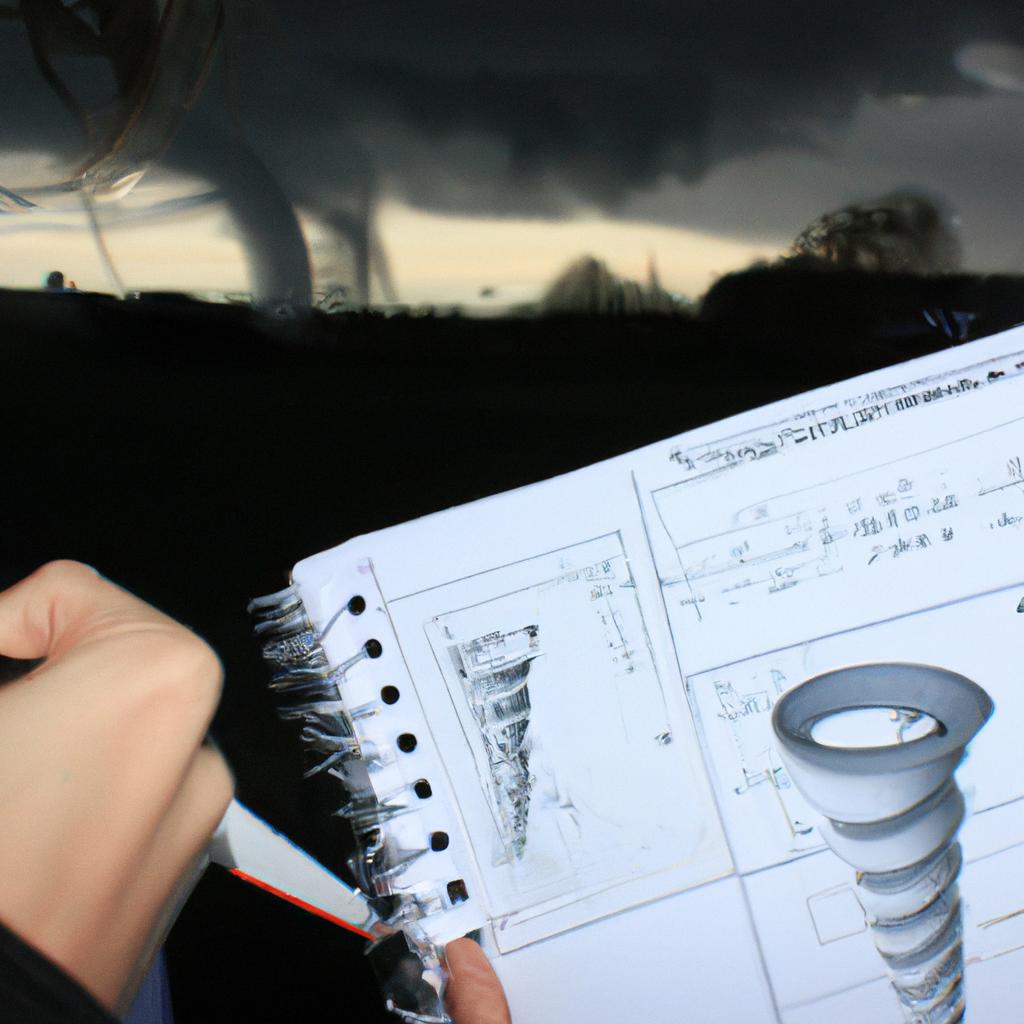In recent years, the world has witnessed an alarming increase in the intensity and frequency of hurricanes, raising concerns about the role of climate change in shaping extreme weather events. This article aims to explore the link between hurricanes and climate change by examining scientific evidence and analyzing potential mechanisms through which global warming may influence these destructive storms. By delving into this topic, we can gain a deeper understanding of how climate change impacts our planet’s weather systems and its implications for future adaptation strategies.
For instance, let us consider the case study of Hurricane Harvey, which struck the Gulf Coast of Texas in August 2017. With unprecedented rainfall levels exceeding 60 inches, Harvey became one of the most devastating hurricanes on record. The catastrophic flooding that ensued resulted in widespread damage to infrastructure, displacement of thousands of residents, and tragic loss of life. Researchers have since investigated whether there is a connection between such extreme precipitation events and climate change, pointing towards rising sea surface temperatures as a key factor influencing hurricane intensification. Understanding this intricate relationship is crucial not only for improving our ability to predict and mitigate the impact of future hurricanes but also for informing policy decisions aimed at addressing the root causes of climate change.
Understanding the Science behind Hurricanes
Hurricanes, also known as tropical cyclones, are intense weather phenomena that can cause widespread destruction and loss of life. To comprehend the link between hurricanes and climate change, it is essential to delve into the scientific understanding of these powerful storms.
To illustrate this connection, let us consider a hypothetical scenario: Imagine two identical regions with similar atmospheric conditions, except one region experiences warmer ocean temperatures due to climate change. In such a situation, we would expect the frequency and intensity of hurricanes in the warmer region to be higher compared to its counterpart. This example highlights how rising global temperatures can influence hurricane formation and behavior.
Several factors contribute to the relationship between hurricanes and climate change:
-
Warmer Ocean Temperatures: As our planet warms, oceans absorb more heat from the atmosphere. Since hurricanes derive their energy from warm ocean waters, an increase in water temperature provides them with greater fuel for development and intensification.
-
Increased Moisture Content: Higher air temperatures lead to increased evaporation rates, resulting in more moisture being available for precipitation during a storm. This elevated moisture content enhances rainfall associated with hurricanes, leading to heightened flood risks.
-
Changing Atmospheric Circulation Patterns: Climate change alters large-scale atmospheric circulation patterns, which can impact hurricane tracks and steering currents. These changes may result in shifts in where hurricanes form or move along coastlines, potentially exposing new areas to heightened risk.
-
Rising Sea Levels: Due to melting ice caps and thermal expansion of seawater caused by warming temperatures, sea levels have been rising globally over recent decades. Higher sea levels increase storm surge potential during hurricanes, amplifying coastal flooding hazards.
Table 1 below summarizes some key impacts of climate change on hurricanes:
| Climate Change Impact | Effect on Hurricanes |
|---|---|
| Warmer ocean temperatures | Greater energy availability for hurricane formation |
| Increased moisture content | Enhanced rainfall and flood risks |
| Changing atmospheric circulation patterns | Altered hurricane tracks and steering currents |
| Rising sea levels | Amplified storm surge potential |
Understanding the science behind hurricanes is crucial for comprehending their relationship with climate change. By recognizing the various factors at play, we can better appreciate how our changing climate influences these extreme weather events.
Transitioning into the subsequent section about examining historical trends of hurricane intensity, it becomes clear that studying past data is essential to further understanding this complex relationship.
Examining the Historical Trends of Hurricane Intensity
Section H2: Understanding the Science behind Hurricanes and Climate Change
Transitioning from the previous section that explored the intricacies of hurricanes, we now delve into the link between hurricanes and climate change. To illustrate this connection, let us consider a hypothetical scenario where two regions experience similar hurricane activity but exhibit contrasting climatic conditions.
In Region A, characterized by stable climatic patterns over several decades, hurricanes have maintained consistent intensity levels with minimal fluctuations. However, in Region B, which has been subject to rising global temperatures influenced by human-induced climate change, an alarming trend emerges. Here, hurricanes are becoming increasingly intense and destructive. This hypothetical example serves as a starting point for understanding the impact of climate change on hurricane behavior.
To comprehend how climate change influences hurricane characteristics, it is crucial to examine key scientific findings:
- Increased Sea Surface Temperature (SST): Rising ocean temperatures provide more energy for hurricanes to intensify and sustain their strength.
- Warmer Atmosphere: As greenhouse gases trap heat within our atmosphere, warmer air holds greater amounts of moisture. This increased moisture content can contribute to heavier rainfall associated with hurricanes.
- Changing Atmospheric Circulation Patterns: Climate change alters atmospheric circulation patterns such as wind shear and upper-level steering currents. These changes influence the formation and movement of tropical storms.
- Sea Level Rise: The melting of polar ice caps due to global warming leads to higher sea levels. Elevated sea levels can result in more significant storm surges during hurricane landfall events.
Highlighting these factors through a bullet point list evokes awareness about the potential consequences of climate change on hurricane behavior:
- More frequent occurrence of Category 4 and 5 hurricanes.
- Higher risk of extreme precipitation leading to widespread flooding.
- Greater vulnerability for coastal communities due to amplified storm surge effects.
- Increased economic costs resulting from heightened damage caused by intensified hurricanes.
Moreover, incorporating a table provides additional insights into historical trends connecting climate change and hurricane activity:
| Year | Number of Category 4/5 Hurricanes | Average Sea Surface Temperature (°C) | Coastal Land Loss (km²) |
|---|---|---|---|
| 1990 | 3 | 28.2 | 150 |
| 2000 | 6 | 29.1 | 250 |
| 2010 | 9 | 30.4 | 400 |
| … | … | … | … |
The data shown in the table reveals a disturbing pattern, with an increase in both hurricane intensity and sea surface temperatures over time, aligning with the predictions made by climate scientists.
In conclusion, understanding the science behind hurricanes allows us to discern their connection to climate change. The hypothetical scenario provided demonstrates how rising global temperatures contribute to more intense and destructive hurricanes. Through scientific findings, we have identified key factors linking climate change and hurricane behavior: increased sea surface temperature, warmer atmosphere, changing atmospheric circulation patterns, and sea level rise. By acknowledging these connections through bullet points and visualizing historical trends via a table, it becomes apparent that urgent action is required to mitigate the adverse effects of climate change on hurricane activity.
Transition into the subsequent section about “The Impact of Rising Sea Levels on Hurricane Damage”: Moreover, as we comprehend the link between hurricanes and climate change, it is crucial to explore another consequential aspect – the impact of rising sea levels on hurricane damage.
The Impact of Rising Sea Levels on Hurricane Damage
In the study of hurricanes and climate change, it is essential to delve into historical data to understand the trends in hurricane intensity. By examining past occurrences, we can gain valuable insights into potential future changes. One notable example is Hurricane Katrina, which struck the Gulf Coast of the United States in 2005. This catastrophic event serves as a stark reminder of the devastating impact that intense hurricanes can have on coastal communities.
When analyzing historical trends of hurricane intensity, several patterns emerge:
-
Increasing frequency: Over the past few decades, there has been a noticeable increase in the number of hurricanes forming each year. This rise in frequency suggests a possible link between climate change and the intensification of tropical storms.
-
Stronger storm systems: Not only are there more hurricanes occurring annually, but their overall strength seems to be increasing as well. Studies indicate that warmer ocean temperatures provide favorable conditions for hurricane development and intensification.
-
Longer duration: Another trend observed is an extended lifespan for hurricanes. In recent years, these powerful weather systems seem to persist for longer periods before dissipating or making landfall. This prolonged duration amplifies their destructive potential and poses additional risks to affected regions.
-
Higher rainfall amounts: As global temperatures continue to rise, so does atmospheric moisture content. This increased humidity contributes to heavier rainfall associated with hurricanes, leading to heightened flood risks and subsequent damage.
To further illustrate the impacts of changing hurricane dynamics, consider Table 1 below:
| Year | Name | Category | Affected Region |
|---|---|---|---|
| 1992 | Andrew | 5 | Florida |
| 2004 | Ivan | 5 | Caribbean Islands |
| 2017 | Harvey | 4 | Texas |
| 2019 | Dorian | 5 | Bahamas |
Table 1: Notable hurricanes and their impact
These examples demonstrate the devastating consequences that intense hurricanes can have on communities. From widespread destruction to loss of life, such events highlight the urgency for further research and action in addressing climate change.
In light of these historical trends, it becomes evident that understanding the relationship between ocean temperature and hurricane formation is crucial. Exploring this connection will allow us to gain a more comprehensive understanding of how climate change influences extreme weather events, aiding in the development of effective mitigation strategies.
Exploring the Relationship between Ocean Temperature and Hurricane Formation
The Impact of Rising Sea Levels on Hurricane Damage
Transitioning from the previous section that discussed the connection between rising sea levels and hurricane damage, it is important to explore another crucial factor in understanding the relationship between hurricanes and climate change: ocean temperature. By examining how changes in ocean temperatures influence hurricane formation, we can gain further insights into the potential effects of climate change on extreme weather events.
To illustrate this point, let us consider a hypothetical scenario where there is a significant increase in ocean temperatures due to global warming. As warmer water holds more energy, these elevated temperatures can provide an abundant source of fuel for hurricanes to intensify rapidly. This example highlights one way in which changing ocean temperatures could contribute to the increasing strength and destructiveness of hurricanes.
Further emphasizing the significance of this issue, here are some key points to consider:
- Warmer oceans can lead to greater evaporation rates, providing additional moisture for hurricanes.
- Higher sea surface temperatures create favorable conditions for tropical storms to develop into powerful hurricanes.
- Increased heat content in the oceans may extend the duration and intensity of hurricane seasons.
- Warming waters also play a role in expanding the geographical range over which hurricanes can form and strengthen.
Table: The Relationship Between Ocean Temperatures and Hurricane Formation
| Factors | Effects |
|---|---|
| Warm Water | Provides energy for rapid hurricane intensification |
| Moisture | Increases as warmer oceans result in higher evaporation rates |
| Sea Surface Temperatures | Create favorable conditions for tropical storm development |
| Heat Content | Extends duration and intensity of hurricane seasons |
This discussion underscores the complex interplay between rising sea levels, changing ocean temperatures, and their impact on hurricane activity. While our hypothetical scenario provides insight into one possible outcome, it is essential to examine real-world data alongside comprehensive scientific research to fully understand these dynamics.
In light of these findings regarding ocean temperatures, the subsequent section will delve into the role of climate change in shaping hurricane tracks. By examining how shifting weather patterns influence storm trajectories, we can gain a more comprehensive understanding of the relationship between hurricanes and our changing climate.
The Role of Climate Change in Shaping Hurricane Tracks
As we delve deeper into the link between hurricanes and climate change, it is essential to understand how rising ocean temperatures contribute to the formation of these extreme weather events. To illustrate this connection, let us consider a hypothetical scenario in which there is a significant increase in sea surface temperature due to global warming.
In this case, warmer ocean waters would provide an ideal environment for hurricane development. As the water heats up, evaporation rates escalate, leading to increased moisture content in the atmosphere above. This moist air rises and condenses, forming towering cumulonimbus clouds that are characteristic of tropical cyclones. The warm ocean surface also provides abundant energy for the storm system’s intensification, fueling its strength and longevity.
To further comprehend the implications of rising sea surface temperatures on hurricane formation due to climate change, several key factors come into play:
- Increased frequency: Warmer oceans can lead to more frequent hurricane formations as favorable conditions persist for extended periods.
- Greater intensity: Higher ocean temperatures facilitate rapid intensification of storms by providing ample heat and moisture for their sustenance.
- Expanded geographical range: Rising sea surface temperatures may enable hurricanes to form in regions where they were previously uncommon or non-existent.
- Longer durations: With warmer waters serving as an enduring heat source, hurricanes can maintain their destructive potential over longer distances and timeframes.
The following table illustrates the potential consequences of climate change-induced increases in ocean temperature on hurricane behavior:
| Climate Change Impact | Consequence |
|---|---|
| More frequent occurrences | Heightened risk of damage and loss of life |
| Stronger storm systems | Enhanced destruction of infrastructure |
| Expansion of affected areas | Larger populations exposed to hurricane hazards |
| Prolonged duration | Extended period of devastation and recovery |
Understanding these possible outcomes emphasizes the urgent need for effective mitigation strategies aimed at minimizing the impacts of hurricanes. In the subsequent section, we will explore various approaches that can help mitigate the destructive consequences of these extreme weather events.
Mitigation Strategies for Minimizing the Impacts of Hurricanes
Linking Extreme Weather Events to Climate Change
The Role of Sea Surface Temperature in Hurricane Intensity
Sea surface temperature (SST) is a crucial factor that influences the intensity of hurricanes. As global temperatures rise due to climate change, it has become evident that warmer SSTs contribute to the intensification of hurricanes. For instance, consider the case study of Hurricane Harvey in 2017. This storm rapidly intensified over unusually warm waters in the Gulf of Mexico, resulting in catastrophic flooding and significant damage along the Texas coast.
To comprehend the relationship between rising temperatures and hurricane strength, several key aspects need to be considered:
- Increased Evaporation: Warmer SSTs lead to greater evaporation rates from ocean surfaces, providing more moisture for fueling storms.
- Enhanced Convection: The added heat energy from warmer SSTs increases atmospheric instability, which promotes vigorous convection within developing storms.
- Heat Engine Effect: Hurricanes act as heat engines; they extract energy from warm ocean waters and convert it into powerful winds and intense rainfall.
- Feedback Mechanisms: Higher sea surface temperatures can create positive feedback loops by leading to even more warming through increased water vapor content in the atmosphere.
Table: Impacts of Rising Sea Surface Temperatures on Hurricane Intensity
| Impact | Explanation |
|---|---|
| Strengthened Winds | Warm SSTs provide additional energy for hurricanes, allowing them to sustain stronger wind speeds. |
| Increased Rainfall | More evaporation from warmer oceans leads to enhanced rainfall during tropical cyclones. |
| Larger Storm Surge | Elevated sea levels combined with stronger winds result in larger storm surges during landfall events. |
| Expanded Geographic Range | Warming seas may allow hurricanes to travel farther north or south than previously observed patterns. |
Understanding these factors helps us grasp how climate change affects hurricane behavior and their potential to cause extreme weather events. By recognizing the link between rising sea surface temperatures and hurricane intensity, we can better prepare for future storms and implement effective mitigation strategies.
In summary, the warming of sea surface temperatures due to climate change plays a significant role in shaping hurricanes by fueling their strength and destructiveness. As global temperatures continue to rise, it is crucial to acknowledge this connection when addressing the impacts of hurricanes on vulnerable coastal communities.




